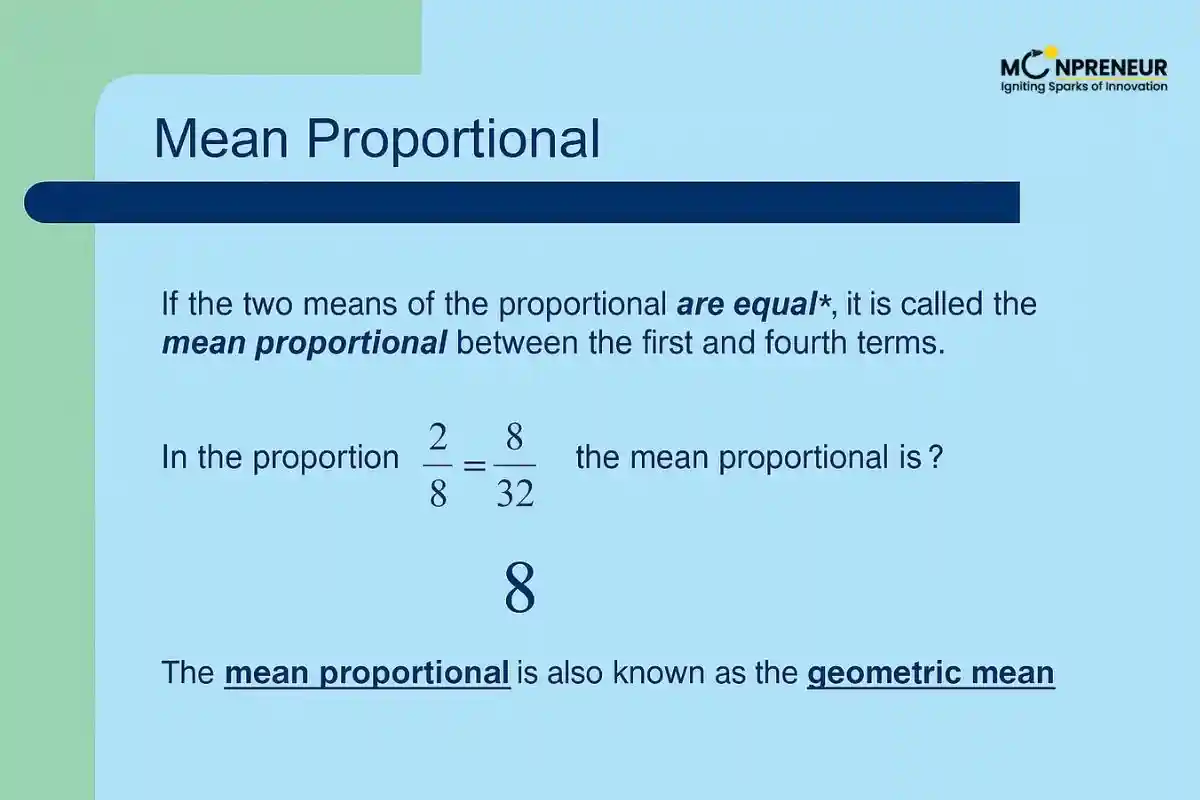The term Mean Proportional is also referred to as the Geometric Mean. It is different from the Arithmetic Mean, which is commonly used when we talk about mean, median, or mode. While the Arithmetic Mean deals with addition and averaging, the Geometric Mean or Mean Proportional deals with multiplication. Understanding Mean Proportional is crucial in ratio, proportion, and geometry. Let us explore its definition, formulas, theorems, examples, and applications.
What is Mean Proportional?

In Mathematics, the Mean Proportional between two terms of a ratio is calculated by taking the square root of the product of the two quantities. For example, in a ratio p:q, the mean proportional is \(\displaystyle \sqrt{p \times q}\) . Mathematically, the Mean Proportional is expressed as:
\(\displaystyle \text{Mean Proportional } (x) = \sqrt{p \times q}\)Define Mean Proportion
The Mean Proportion or Geometric Mean of two positive numbers p and q is the positive number x such that:
\(\displaystyle \frac{p}{x} = \frac{x}{q} \;\;\Rightarrow\;\; x^{2} = p \times q \;\;\Rightarrow\;\; x = \sqrt{p \times q}\)Note: The Geometric Mean or Mean Proportion is always positive because we consider the positive square root.
Example: Mean Proportional
Find the Mean Proportional between 4 and 25.
Solution:
\(\displaystyle x^{2} = 4 \times 25 = 100 \;\;\Rightarrow\;\; x = 10\)Therefore, the Mean Proportional between 4 and 25 is 10.
Right-Angled Triangle and Mean Proportion
In geometry, the concept of Mean Proportional appears in right-angled triangles through important theorems.
Theorem 1
The altitude drawn to the hypotenuse of a right-angled triangle creates two smaller triangles that are similar to each other and to the original triangle.
\(\displaystyle \triangle ADC \sim \triangle CDB,\quad \triangle ACB \sim \triangle ADC,\quad \triangle ACB \sim \triangle CDB\)
Altitude Rule
The altitude to the hypotenuse of a right-angled triangle is the Mean Proportional between the left and right segments of the hypotenuse.
\(\displaystyle AD^{2} = BD \times DC\)
Leg Rule
The legs of a right-angled triangle are the Mean Proportional between the hypotenuse and the segment of the hypotenuse adjacent to that leg.
\(\displaystyle AB^{2} = BD \times BC \quad \text{and} \quad AC^{2} = DC \times BC\)
Examples with Solutions
-
Find the Mean Proportional between 4 and 9.
\(\displaystyle x^{2} = 4 \times 9 = 36 \;\Rightarrow\; x = 6\)
-
Find the Mean Proportional between 9 and 16.
\(\displaystyle x^{2} = 9 \times 16 = 144 \;\Rightarrow\; x = 12\)
-
In a right triangle, if BD + DC = 16, find AB using the leg rule.
\(\displaystyle \text{Using leg rule: } AB^{2} = BD \times BC \;\Rightarrow\; AB = 12\)
-
Find the altitude AD if \(\displaystyle \mathbf{BD \times DC = 49}\).
\(\displaystyle AD^{2} = BD \times DC = 49 \;\Rightarrow\; AD = 7\)
Importance of Mean Proportional
Mean Proportion is one of the most essential concepts in mathematics. It helps establish relationships between numbers and is used in various theorems, especially in geometry. By mastering this topic, students can easily solve problems related to right-angled triangles, ratios, and proportions.
Applications include:
– Finding the altitude, hypotenuse, and base in right-angled triangles.
– Determining proportional relationships between numbers.
– Providing quick revision material during exam preparation.
Tips for Solving Mean Proportional Questions
- Understand the formulas and theorems clearly before attempting problems.
- Read the question carefully to identify which formula applies.
- Practice examples to learn the correct sequence of solving steps.
- Write every step clearly in exams as step-by-step marking is common.
- Memorize the formulas and definitions to avoid confusion during exams.
Facts to Remember
- Mean Proportional is also called Geometric Mean.
- In Geometric Mean, the values of both x in \(\displaystyle \frac{p}{x} = \frac{x}{q}\) are equal.
- Mean Proportional is always positive.
- It is different from Arithmetic Mean, which deals with averages through addition.
Conclusion
The Mean Proportional, also known as the Geometric Mean, is a key mathematical concept used in ratios, proportions, and geometry. With simple formulas like \(\displaystyle \sqrt{a \times b}\) and theorems related to right-angled triangles, it forms the foundation for solving many mathematical problems. By practicing step-by-step examples, students can strengthen their understanding and excel in exams.
Want to spark your child’s interest in math and boost their skills? Moonpreneur’s online math curriculum stands out because it engages kids with hands-on lessons, helps them apply math in real-life situations, and makes learning math exciting!
You can opt for our Advanced Math or Vedic Math+Mental Math courses. Our Math Quiz for grades 3rd, 4th, 5th, and 6th helps in further exciting and engaging in mathematics with hands-on lessons.
Related Blogs:
Step Deviation Method in Statistics – Definition, Formula, and Solved Example
What is the Frequency Formula? Definition, Examples, and Related Equations
What Is the SAT Essay? Everything You Need to Know
An overview of the SAT Math Test Sections
SAT Superscore: What It Is and Why It Matters?
Mean vs. Median vs. Mode: What is the Difference?
Mathway Reviewed: Pros, Cons, and Everything You Need to Know















